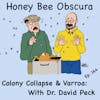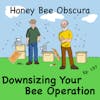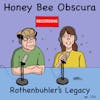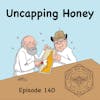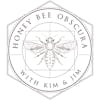Beehive Life (135)

What else is in a beehive other than... honey bees? If you stop and look closer the next time you are in your beeyard, you will in all likelihood begin to notice all manner of living creatures sharing the beeyard space with you and your bees. Some,...
 What else is in a beehive other than... honey bees?
What else is in a beehive other than... honey bees?
If you stop and look closer the next time you are in your beeyard, you will in all likelihood begin to notice all manner of living creatures sharing the beeyard space with you and your bees.
Some, most in fact, are not a problem for your bees and in fact, many are actually beneficial to your bees. These ‘pests’ clean up the messes from your bees.
Once you look inside the hive, you may find even more of these creatures making a home alongside the bees. Some are really pests, eating larvae, adult bees, beeswax, honey and generally making a mess. Others are completely benign, simply using the hive as a convenient place to get out of the rain, stay warm in, or hide from their predators
Kim and Jim offer some interesting insights to all of these creatures. Listen in and find out what those earwigs, ants and springtails can do!
______________________
Thanks to Betterbee for sponsoring today's episode. Betterbee’s mission is to support every beekeeper with excellent customer  service, continued education and quality equipment. From their colorful and informative catalog to their support of beekeeper educational activities, including this podcast series, Betterbee truly is Beekeepers Serving Beekeepers. See for yourself at www.betterbee.com
service, continued education and quality equipment. From their colorful and informative catalog to their support of beekeeper educational activities, including this podcast series, Betterbee truly is Beekeepers Serving Beekeepers. See for yourself at www.betterbee.com
______________________
Honey Bee Obscura is brought to you by Growing Planet Media, LLC, the home of Beekeeping Today Podcast.
Music: Heart & Soul by Gyom, All We Know by Midway Music, original guitar music by Jeffrey Ott
Copyright © 2023 by Growing Planet Media, LLC

Episode 135 – Beehive Life
Jim Tew: Kim, yesterday afternoon, I was out in my bee yard again. Here it is, early July, hot days, grass needs cutting, and I was struck by something that I've noticed hundreds of times through the decades. There's a lot of life in my bee yard besides bees. It's like a big box shopping store back there.
Kim Flottum: [laughs] Yes. The way things have been going this summer when I'm in the bee yard, I've got a little more time than I normally have had over the last couple of decades, it seems, and I'm able to look around. I'm standing here looking at the ground. I'm watching what's crawling over my foot, what's crawling up the side of the hide, all the little things. We've talked about the big things before, bears and skunks and raccoons and those sorts of things. You're right, there's a city in our bee yard.
[music]
Jim: I got more questions than I have answers, as usual. Let's chat about it for a while.
Kim: All right.
Jim: Hi, I'm Jim Tew.
Kim: I'm Kim Flottum.
Jim: We're coming to you from Honey Bee Obscura, where today we want to talk about all the things in our bee yards that are not bees.
Kim: At least most of them. I don't think I know all of them.
Introduction: You are listening to Honey Bee Obscura, brought to you by Growing Planet Media, the folks behind Bee Keeping Today podcast. Each week on Honey Bee Obscura, hosts Kim Flottum and Jim Tew, explore the complexities, the beauty, the fun, and the challenges of managing honey bees in today's world. Get ready for an engaging discussion to delight and inform all beekeepers. If you're a long timer or just starting out, sit back and enjoy the next several minutes as Kim and Jim explore are all things honey bees.
Jim: You see, the thing that's really on my mind that made it stand out was a green bottle fly, a common blowfly. Why are they all around the entrance of my colony? The colony isn't weak. There's no open disease to brood. There's no decaying plant life, animal life. Why is that fly nosing around? Then it's very, very flighty. I wanted to take a picture of it and then see if I could use some computer program and in a way cheat and let it ID the fly instead of me trying to do it the old-fashioned way. That fly would have no part of that. You get inside of two feet of that fly with the camera and it's gone. These flies are always sitting around and there's different species of them. I want to use that as one example. What attracts this outside animal life to my beehive?
Kim: I think off the top of my head, now that you got me thinking about it, the inside of a beehive is warm, it's dry. There's all kinds of food in there, depending on what your diet is. If you like dead bees, there's probably two or three of those on the bottom board or on the front entrance. If you like live adult bees, there's millions of those. If you like eating small children, there's a lot of those in there too. Plus honey and pollens. The inside of a beehive is-- What did you use? One of those super stores. That's just inside. Outside are all the customers.
Jim: The way that we've got our hives set up, if the bees were in a tree and they were 6six, seven, eight feet off the ground coming out of a knot hole or a crack, they physically have enough aerodynamics to carry out, for instance, one of their fallen comrades, which is basically the same body weight as the house cleaning bee. When that bee comes out and takes flight, she goes into a hard nosedive like a heavily laden plane trying to take off a short runway, and she can just barely get airborne and take off carrying that full load. What happens? We put our beehives either close to the ground or sometimes on the ground, and they can't get off the ground.
Where I'm going with this is a compost pile of dead bees accumulates in front of our hives because the bees physically can't take flight to clean. Then everything comes to that. Yellow jackets, all kinds of degraders, other life. They don't do any harm that I know of, do they? They're drawn to what? I guess the odor of decaying animal life, these degraders that show up.
Kim: When that's your diet, dead things, that's probably given off a here's supper for the next three months signal. If I'm eating dead bees for a living, I'm going to stick around there. There's a lot of things that eat dead bees for a living.
Jim: I don't really mind them there. The point I want to make is, and we keep going back to it, this is like a community. We, you and I as beekeepers, see my and your bee yard as a bee yard. We even name it a bee yard. Would a better life be, and this is just me being funny now, Kim, would a better name for our bee yard be a life yard? Because it's teeming with life. I don't want to go into it because I am profoundly not qualified. If we looked inside the hive and went down at the small level at what we can't see, for the macro vision, I'm not talking micro, but macro, there's even more creepy, crawling things that are in and around the beehive.
Is this thing like a beaver dam? Is a beehive in any way like a beaver dam where a beaver comes in, takes out a small stream, puts the dam across it, builds the dam, works on the dam, maintains the dam, finally gets a pond behind it. Then within two years, there's fish and frogs and aquatic life. Is a beehive anything like that beaver dam environment?
Kim: That's an interesting way to look at it. I've never thought about it like that, but I think you're onto something there. Here's another thing. Now that you got me thinking here about 30 years of keeping bees and not paying close attention, but a little bit of attention. The creatures that you see in the bee yard when you're standing there looking at a frame and you look down at your foot and there's things moving, change over the course of the season. In the spring, you'll have these, and in midsummer, you'll have these, and come fall you'll have these too. Some of them last all year, and some of them come, are there, and then are gone. Now that you got me thinking about it.
Jim: Now you got me thinking. Before you get on with that, that's really interesting that the degraders, if that's what they are, the composters, the hive invaders, they seasonally change as the dynamic to the hive changes, as the dynamics of either the cavity or the food supply changes. Good point, Kim.
Kim: The food supply, you're talking about those yellow jackets, for instance, that are carrying away dead bees. Early in the spring, those yellow jackets, if they find one bee, it's going to last them a couple of days. By mid July, one bee is going to maybe get back to their nests before it gets eaten, but certainly will be eaten the minute that yellow jacket walks into the nest because the demand for food back home has multiplied manyfold. That yellow jacket is going to tell her nest mates, "I got a whole hive full of this stuff. Follow me."
Jim: I'm trying to follow you right now, but this is a great concept. Taken my topic and made a better topic of it. The yellow jackets, in this case, the yellow jackets' needs are going to change because both her population dynamics and her nest's needs are changing. We're not surprised to see that in the spring of the year, you see yellow jacket queens. Then over time, you begin to see more and more worker yellow jackets. Then by July and August, the yellow jackets are in full swing back there eating those dead bees. Kim, I can't tell that yellow jackets really do anything harmful other than clean things up.
I think if there's a beehive that's run down, weak, diseased, been robbed, hanging on by a prayer, I think the yellow jackets could be part and parcel into finishing that colony. I can't say that the yellow jackets are the reason that colony got in that shape. I think a lot of these uninvited visitors are opportunists who are just looking for a food supply anywhere. On a farm, around your garbage can, by my beehives or wherever. That we're making it sound like these are special visitors because they preferentially chose beehives. I think they just probably chose a food supply and this happened to be it.
Kim: In the bigger world, I think you got it right on the head there. I think that's exactly right. It's eat or be eaten. Here's another one. I still use a telescoping outer cover. Do you ever take off a telescoping outer cover and have enough ants covering the inner cover?
Jim: Yes.
Kim: I've stood there and I looked at that, and I think these animal species, these insect species, are living amicably. The ants have agreed to live on the inner cover, and the bees have agreed to live beneath the inner cover. They're both happy until I show up, the perpetual intruder, and mix up the ant nest and scatter 'em everywhere. I don't want them there. I don't guess the bees cared. They didn't make an effort to get 'em out. Yes, I have seen that a thousand times. I have seen that as recently as yesterday when I opened some empty equipment and there was a carpenter ant nest in there. It wasn't a big one.
I thought, "You can just stay here," because I realized I'm not exactly sure what carpenter ants eat, but I'm hoping that if given the opportunity, they would eat wax moths. At least it's a different pest. Instead of wax moths, I've got a case of carpenter ants in one of my empty hives back there in my city community and my bee yard
Jim: [laughs] You can ratchet it up just a notch. The same seasonal pattern follows a lot of the things that you're going to see in your bee yard. Springtime is when they have litters, when they lay eggs, and when they start building their population. Summer's when their population is steadying out. Fall, the population begins to decrease. If I'm thinking, I'll mention ants, but I'm also thinking like springtails and spiders and things. In the spring, you don't have many because there aren't many. In the summer you have about as many as you're going to have. By fall they're probably gone, or they have expanded to the point where they own the hive and you don't anymore.
Kim: That's exactly right. They take it over. Give me a second to think about that because you touched a nerve when you said springtails. Let's hear from our sponsor, and I want to talk about that.
[music]
Betterbee: At Better Bee, we know you have many options for where you choose to get your wooden hive boxes and frames. We work closely with our sister company, Humble Abodes in Maine, to bring you high-quality wooden wear, featuring tight-fit assembly available in a variety of grade options to meet your needs. Whether you choose select commercial or budget grade boxes or frames, you can count on quality milling of locally sourced eastern white pine. Shop all wooden wear at betterbee.com.
Jim: My daughter almost feels like that she's under siege. There's something in her house trying to get her. There's ants, there's the occasional spider. She began to call me Kim, telling me she was having a springtail invasion in one of her lower humid bathrooms. I've never really heard of such. When I was an entomologist in training, springtails was the kind of thing that you needed to get to satisfy the requirements for an insect collection. Otherwise, it was just this tiny little critter, like a thrips. You had to put it on a microscope slide or in an alcohol bottle to even see it.
Hear my daughter is saying that she's got a little springtail invasion and the shower pan in her lower bathroom. Since I'm a beekeeper and entomologist, sure, you would just be able to tell me everything in the world about these Collembola. No, I knew almost nothing. Other than the fact that I needed them all those years ago for my insect collection. Here's where I'm going, Kim. I thought, "You don't suppose," the web and the web knows everything I asked, "Do Springtails ever get in beehives?" Yes. The answers came back immediately, but it all came back anecdotal information from beekeepers that they were finding all these tiny half-size flea-looking critters that were spring loaded flying all over the place, jumping around, popping like miniature life inside the beehive.
Where I wanted to go was how in the world did these animals in the grouping Columbola, tiny that they are, how did they get up in the detritus on the bottom board of that beehive and establish a population there? That was the thing, that and the blow flies and the earwigs and the ants. There's a lot of interest in beehives from things other than bees. I don't know what the relationship is. Is that relationship always bad? Is that relationship sometimes bad or is it actually good for the bees, whatever's there? I have no idea. I'm sure it depends on the critter you're talking about. Yes, beekeepers, add this to your list of things you can have in your beehive.
You can have microscopic springtails in the grouping Columbola that can be in your beehive, seemingly doing absolutely nothing wrong other than eating and degrading what's left in the bottom board. Droppings there.
Kim: Way back in Wisconsin days, I had one of the hives that we had there at the bee Lab had springtails. I had no concept of what a spring tail, I don't think I'd ever seen one. Didn't know anything about it. The guy I was with, he took the cover off and he says, "Now watch this." He very carefully took the cover off, it was an overlapping cover, very carefully, very quietly. He said, "You're ready for this?" He got it loose all the way around and he put a hand on both sides and he lifted that thing up above his head that fast. A hundred springtails that were sitting on the inner cover made the inner cover look like a pan of popcorn popping.
Jim: Wow. [laughs] I've never heard that story.
Kim: They were just going up and up and up and some of them were falling in down into the hives. Some of 'em were jumping outside the edge and they're just hopping. He said, "Give it a minute. Give it a minute." We're standing there and they're hopping and they're less hopping and they're not hopping and they go back to normal, even with the cover off that time. I don't know if that's normal behavior or not. You just mentioned springtails on the bottom board because they're scavengers. What they're looking for in that beehive is the dead bees, that kind of thing. Up on the undercover, and bam, it was just like popcorn.
Jim: I've never seen that. My story from long, long ago when I was keeping bees in South Alabama was European earwigs. They were just in such great numbers as to be annoying. I don't want to offend anybody who's producing honey, but one of the main things that my honey filter would catch would be those earwigs because, in homology terms, they're dorsal laterally flattened. They can lay inside that cell perfectly flattened and hold on, and really do a nice job. They don't shake out and fall out. About five years ago, for the first time ever, I began to see earwigs in my beehives.
I think they're also detritus feeders, but I don't know. There was one lone Russian paper. I think I've got this out of one of the main bee books, it's not my information, that speculated that earwigs might be a secondary vector for European foulbrood, but otherwise, they're just there. People do not want earwigs in their honey. You got to have a filter system to get that out. The dead bees and the particles of wax. I've got pictures, I made 'em back here in my beehive. One of the things that somehow finds its way to my beehive city has been earwigs in the last few years. I'm not invaded like I was in Alabama.
Kim, then there's cockroaches. Good heavens, those things once they take over. I used to say it was just the warm humid states that I lived in but I've seen cockroaches on the inner covers and then the various devices on top of the hive, and they do like ants. They just seem to coexist there. The only time I see them in the colony is when I disrupt things. I disrupt the status quo and then they run down into the colonies there. As a new beekeeper, you'd think, "The bees will kill them." No, they won't. Cockroaches run around. Bees run around. Everybody's excited. A lot of confusion.
All of a sudden the hive is light inside. It was pitch black a minute ago, I guess in the bedlam it's just a free for all. There's no time for those guys to really fight each other until they get their organization back. Help me out.
Kim: I'm going back a half a step to earwigs. My experience with earwigs is pretty minimal, but the people I know that have been dealing with them find in empty combs, flat on the bottom, hiding. The one experience I had with a highly infested, well, I think it was highly infested colony. The beekeeper went in, took the cover off, pulled up a frame, set the cover down on his high stand. He banged the frame because there was a top side and the bottom side. Both sides of the comb, there was one side of the comb was up, one side of the comb was down. He banged it, and all of the earwigs fell out of the downside of that comb when he banged it on. There was, I don't know, 75 or 100 of them. It was like the popcorn thing. From all I understand they're just hiding, but cockroaches, I'm sure that they're not eating live bees. What they're probably doing is warm, dry, safe. I found a home.
Jim: My biggest complaint about the serious cockroach infestation was the excrement that they left. That can just be so messy. I've got my own problems with wax moths and everything else. Kim, we're out of time. I wanted to talk about fire ants, but I'm going to hold that, and maybe you and I can talk about ants, specifically fire ants, later on. I've never really known if fire ants are good guys or bad guys. When I was living in the south, I used to use those fire ants to torment, that's the only word to be used, colonies that had a empty equipment that had a wax moth infestation. I'm saving that. We're out of time.
The point I was making, the thing I wanted to talk with you about for a few minutes was how many other animals live in my bee yard besides bees, and they're there all the time. They've always been there, but it's a bee yard. It's not a life yard. Bees are what I care about the most. That's what I think about the most. There's a lot of animals that really appreciate what the bees do to set up a home site for them.
Kim: I'm going to take this a step further. If you've been listening to this, next time you go out to your bee yard, before you start working your bees, look around. What's underneath, what's next to you, what's on top of your beehive besides bees, because you start paying attention, and if you're good at it, you make notes. Come next winter, you're going to go, "Holy cow, three pages of things were in my bee yard."
[music]
Jim: Yes. It's like bird watching in a beehive except you're other critter watching. [laughs]
Kim: There you go.
Jim: I got to quit. I'm getting goofy. I'm going to go back and have a look again. Enjoyed talking to you, Kim. Till next time, buddy.
Kim: That's always good. Thanks.
[00:22:50] [END OF AUDIO]
New to Honey Bee Obscura Podcast?
Here are some great episodes to start with. Or, check out episodes by topic.









